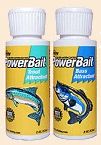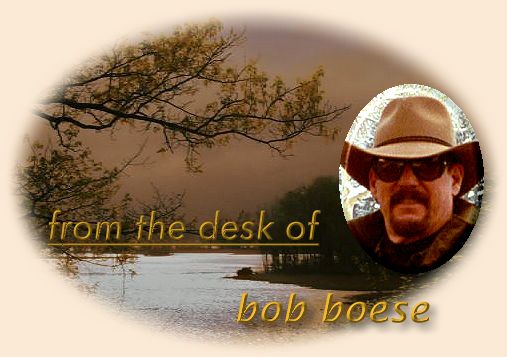
| ||
|
January 12th, 2009
|
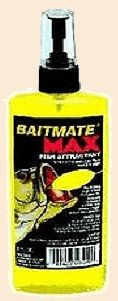
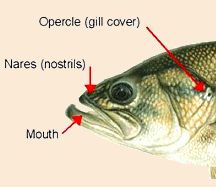 They have nostril looking holes called nares, two on each
side of the mouth, that bring water into an inner chamber
lined with sensory pads (chemoreceptors). When a fish
moves water is forced over the pads and when quiet they
can force water over the pads with muscle movement. The
chemoreceptors pick up chemical signals and transmits them
to the frontal lobes of the brain, which interprets the signal
and the fish responds. Bass and bluegill can smell their "home"
portion of a lake much as ocean species can smell the unique
trace of their home reef and salmon can smell their home river.
They know what nature smells like. For fly fishermen, a serious
problem has been created by the universe of modern flies —
where many have no parts that nature created. What replaced
nature is nylon based threads, chemically processed fiber dubbing
and chenille, plastic and metal tinsel and hair, rubber and silicone l
egs, foam, wire, glues and varnishes. None of these smell like
fish food and many contain smells that repel bass and bluegill.
Gasoline is reputed to be the most repulsive, followed closely
by solvents — like those found in glue and head cement.
Of course there is the amino acid L-Serine, found in
humans and immediately identifiable as a bad thing by bluegill
and bass. Human skin emits L-Serine odor and can (inevitably
will) transfer this to a modern fly. The result is, when bad things
combine, the fly might actually repel fish. Fortunately, there are
items available to fly fishermen that counteract negative influences.
These go by the odious name of "attractants" and no purist fly
fisherman will use them for fear of eternal fishing damnation.
They have nostril looking holes called nares, two on each
side of the mouth, that bring water into an inner chamber
lined with sensory pads (chemoreceptors). When a fish
moves water is forced over the pads and when quiet they
can force water over the pads with muscle movement. The
chemoreceptors pick up chemical signals and transmits them
to the frontal lobes of the brain, which interprets the signal
and the fish responds. Bass and bluegill can smell their "home"
portion of a lake much as ocean species can smell the unique
trace of their home reef and salmon can smell their home river.
They know what nature smells like. For fly fishermen, a serious
problem has been created by the universe of modern flies —
where many have no parts that nature created. What replaced
nature is nylon based threads, chemically processed fiber dubbing
and chenille, plastic and metal tinsel and hair, rubber and silicone l
egs, foam, wire, glues and varnishes. None of these smell like
fish food and many contain smells that repel bass and bluegill.
Gasoline is reputed to be the most repulsive, followed closely
by solvents — like those found in glue and head cement.
Of course there is the amino acid L-Serine, found in
humans and immediately identifiable as a bad thing by bluegill
and bass. Human skin emits L-Serine odor and can (inevitably
will) transfer this to a modern fly. The result is, when bad things
combine, the fly might actually repel fish. Fortunately, there are
items available to fly fishermen that counteract negative influences.
These go by the odious name of "attractants" and no purist fly
fisherman will use them for fear of eternal fishing damnation.
The singing stopped. "Hello?" came the reply.
"Can you hear me?"
"Yes."
"Help! I'm down here!"
Chuck's head appeared over the edge of the cliff
wearing a cap with a Catch-Mo-Fish logo. "I see
that. Hi, Harry."
"Oh, Chuck. Thank goodness. Can you help me?
"Sure. I probably have a rope. Hang on for another
minute."
There was a long pause and the sound of activity on
the top of the cliff. Harry felt his grip slipping. "Please hurry."
"I'm coming."
"Chuck, help me! I'll promise you anything if you'll save me
from here."
"Well…," the end of a rope appeared. How about
you promise to try my Catch-Mo-Fish?"
"HELP! HELP! IS ANYONE ELSE UP THERE?"
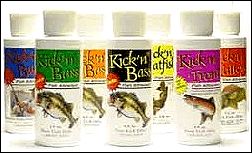 be made at home with mineral oil and added scents from
the spice aisle, and eliminating human scents will help in
panfish catches as well. Field tests with double dropper
rigs of identical flies have shown that an attractant treated
fly outfishes the untreated fly by a factor of 4 to 1. Amazingly,
because the world if full of surprises, WD40 is a great attractant
and now comes in a felt tip dispenser.
be made at home with mineral oil and added scents from
the spice aisle, and eliminating human scents will help in
panfish catches as well. Field tests with double dropper
rigs of identical flies have shown that an attractant treated
fly outfishes the untreated fly by a factor of 4 to 1. Amazingly,
because the world if full of surprises, WD40 is a great attractant
and now comes in a felt tip dispenser.
Wive's Tale #2: Man-made fly tying materials don't smell. Actually, many of these materials are petroleum based and petroleum products are among the most repulsive to fish. Even natural materials which are packaged or stored in plastic bags can pick up odors from the packaging. Wive's Tale #3: Washing your hands gets rid of repulsive odors. Only half true, washing with some floral scented soaps can make things worse. Washing with natural scented or unscented soap (Ivory is good) will wash repulsive odors from human hands.
Wive's Tale #4: Using fish attractant is illegal. Simply false,
even on the most restrictive gold medal fly fish only catch-and-release
waters, no prohibition against attractant on flies has been found. Wive's Tale #5: Using fish attractant ruins the action of the fly. Only half true. Using an oily attractant on a dry fly hackle can ruin the action and sink the fly. Don't do that. Attractant on a wet fly or nymph will have no negative effects. Some attractants come in colors and should be avoided as they will discolor anything (flies, clothes, fingers) — especially the red colored attractants. Wive's Tale #6: Fish attractants can hurt the finish on rods and deteriorate fly line. Heavy application may cause oil spots on a cork handle and cause some discoloration, but no other adverse effects should occur. Wive's Tale #7: You have to coat the entire fly with attractant. Actually, selective application on a fly will suffice to release attractants while masking most other smells. Use a spray bottle or place drops (with a needle or bodkin) on the body of a fly. Wive's Tale #8: Attractants can get rancid on your fly. Only half true. Some attractants with natural products (fish and vegetable oils) will eventually get rancid, but most attractants wash off with fishing and a brief rinsing before returning a fly to a fly box should resolve this issue. One product, KICK'N BASS is particularly difficult to remove from baits, which is not so good in your fly box but is normally considered a plus in other fishing applications. Wive's Tale #9: Fish attractants are poison to humans. No, but probably won't do you any good. Some fish attractants contain "not for human consumption" warnings, but not poison warning labels. Wive's Tale #10: Other fly fishermen will hate you for using attractant. Only half true, the other half will hate you for catching more fish than they do.
GENERIC FISH ATTRACTANT RECIPE
About Bob:Robert Lamar Boese has fly fished for five decades. He is an environmental negotiator, attorney and educator who has provided environmental legal services for more than thirty-three years including active duty with the U.S. Coast Guard and Department of Justice. He is a well known fly tyer with several unique patterns to his credit. He has developed and authored federal and state regulatory programs encompassing a broad spectrum of environmental disciplines, has litigated environmental matters at all levels of the federal and state court systems, and is a qualified expert for testimony in environmental law. He has authored over 60 published text chapters, comments or articles on environmental matters, is a member of the Colorado, District of Columbia and Louisiana Bar Associations, and is a certified mediator. In addition to his legal practice, Mr. Boese has been a high school teacher, an associate professor of Environmental Law and Public Health, has authored numerous fiction and sports publications, and is a softball coach and nationally certified volleyball referee. He is the president of the Acadiana Fly Rodders in Lafayette, Louisiana and editor of Acadiana on the Fly. He has been married for thirty years and is the father of two fly fishing girls (25 and 21). For additional information contact: Boese Environmental Law, 103 Riviera Court, Broussard, LA 70518 or call 337.856.7890 or email coachbob@ymail.com.
|
|
Previous Bob Boese Columns If you would like to comment on this or any other article please feel free to post your views on the FAOL Bulletin Board! 
|
